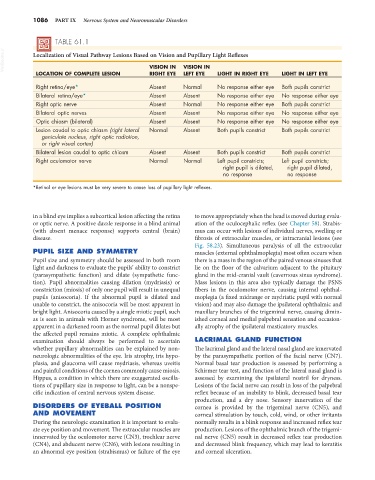Page 1114 - Small Animal Internal Medicine, 6th Edition
P. 1114
1086 PART IX Nervous System and Neuromuscular Disorders
TABLE 61.1
VetBooks.ir Localization of Visual Pathway Lesions Based on Vision and Pupillary Light Reflexes
VISION IN
VISION IN
LOCATION OF COMPLETE LESION RIGHT EYE LEFT EYE LIGHT IN RIGHT EYE LIGHT IN LEFT EYE
Right retina/eye* Absent Normal No response either eye Both pupils constrict
Bilateral retina/eye* Absent Absent No response either eye No response either eye
Right optic nerve Absent Normal No response either eye Both pupils constrict
Bilateral optic nerves Absent Absent No response either eye No response either eye
Optic chiasm (bilateral) Absent Absent No response either eye No response either eye
Lesion caudal to optic chiasm (right lateral Normal Absent Both pupils constrict Both pupils constrict
geniculate nucleus, right optic radiation,
or right visual cortex)
Bilateral lesion caudal to optic chiasm Absent Absent Both pupils constrict Both pupils constrict
Right oculomotor nerve Normal Normal Left pupil constricts; Left pupil constricts;
right pupil is dilated, right pupil dilated,
no response no response
*Retinal or eye lesions must be very severe to cause loss of pupillary light reflexes.
in a blind eye implies a subcortical lesion affecting the retina to move appropriately when the head is moved during evalu-
or optic nerve. A positive dazzle response in a blind animal ation of the oculocephalic reflex (see Chapter 58). Strabis-
(with absent menace response) supports central (brain) mus can occur with lesions of individual nerves, swelling or
disease. fibrosis of extraocular muscles, or intracranial lesions (see
Fig. 58.23). Simultaneous paralysis of all the extraocular
PUPIL SIZE AND SYMMETRY muscles (external ophthalmoplegia) most often occurs when
Pupil size and symmetry should be assessed in both room there is a mass in the region of the paired venous sinuses that
light and darkness to evaluate the pupils’ ability to constrict lie on the floor of the calvarium adjacent to the pituitary
(parasympathetic function) and dilate (sympathetic func- gland in the mid-cranial vault (cavernous sinus syndrome).
tion). Pupil abnormalities causing dilation (mydriasis) or Mass lesions in this area also typically damage the PSNS
constriction (miosis) of only one pupil will result in unequal fibers in the oculomotor nerve, causing internal ophthal-
pupils (anisocoria). If the abnormal pupil is dilated and moplegia (a fixed midrange or mydriatic pupil with normal
unable to constrict, the anisocoria will be most apparent in vision) and may also damage the ipsilateral ophthalmic and
bright light. Anisocoria caused by a single miotic pupil, such maxillary branches of the trigeminal nerve, causing dimin-
as is seen in animals with Horner syndrome, will be most ished corneal and medial palpebral sensation and occasion-
apparent in a darkened room as the normal pupil dilates but ally atrophy of the ipsilateral masticatory muscles.
the affected pupil remains miotic. A complete ophthalmic
examination should always be performed to ascertain LACRIMAL GLAND FUNCTION
whether pupillary abnormalities can be explained by non- The lacrimal gland and the lateral nasal gland are innervated
neurologic abnormalities of the eye. Iris atrophy, iris hypo- by the parasympathetic portion of the facial nerve (CN7).
plasia, and glaucoma will cause mydriasis, whereas uveitis Normal basal tear production is assessed by performing a
and painful conditions of the cornea commonly cause miosis. Schirmer tear test, and function of the lateral nasal gland is
Hippus, a condition in which there are exaggerated oscilla- assessed by examining the ipsilateral nostril for dryness.
tions of pupillary size in response to light, can be a nonspe- Lesions of the facial nerve can result in loss of the palpebral
cific indication of central nervous system disease. reflex because of an inability to blink, decreased basal tear
production, and a dry nose. Sensory innervation of the
DISORDERS OF EYEBALL POSITION cornea is provided by the trigeminal nerve (CN5), and
AND MOVEMENT corneal stimulation by touch, cold, wind, or other irritants
During the neurologic examination it is important to evalu- normally results in a blink response and increased reflex tear
ate eye position and movement. The extraocular muscles are production. Lesions of the ophthalmic branch of the trigemi-
innervated by the oculomotor nerve (CN3), trochlear nerve nal nerve (CN5) result in decreased reflex tear production
(CN4), and abducent nerve (CN6), with lesions resulting in and decreased blink frequency, which may lead to keratitis
an abnormal eye position (strabismus) or failure of the eye and corneal ulceration.

